The blue Andalusian chicken breed profile

The Andalusian or Blue Andalusian, Spanish: Andaluza Azul, is a breed of domestic chicken indigenous to the autonomous region of Andalusia in south-west Spain which includes the cities of Malaga and Seville.
Blue Andalusian chickens have long been known in England and the United States. They are magnificent to look at with their graceful, stately carriage and delicately blue-laced plumage; and this marks them as an especially fine breed for exhibition. The hens are flighty but friendly, curious and not broody. They are good layers of nice white eggs
Blue laced is the only variety accepted by the APA, but when two blues are crossed, 25% will be black and 25% will be splash.
Primary use: Eggs, dual purpose, exhibition,
Conservation status: Watch list, rare.
Size: 20 to 28 inches tall, upright stance.
Weight: Cockerel: 3.2-3.6Kg, Hen: 2.25-2.7Kg. Bantam Cockerel: 680-790g Bantam Hen: 570-680g
Origin: Andalusia, Spain
Class: Mediterranean rare breed.
Types: Large fowl and bantam.
Temperament: Active and flighty, difficult to contain, likes to free range.
Cold hardy: To some extent, the large comb is susceptible to frostbite.
Colours: Blue with lacing. Black and Splash.
Broodiness: Well below average.
Egg colour: White.
Productivity: 160 - 200 large white eggs per year. Passable carcass as a meat bird.
Availability: rare and difficult to find.
Suitability to backyard Life: Not suitable for small areas, need lots of space and high perches.
Useful to Know: My Andalusian can rival my Barnevelders as winter layers, typically producing at least 30 eggs per bird in the three months of winter.
This breed of chicken was used in the genetic experiments of the famous 19th century monk Gregor Mendel and helped him to understand recessive genetic traits, since two blue birds produce half blue offspring and one quarter each each black and white offspring.
What do Andalusian chickens look like?
Andalusian chickens have a single comb, white earlobes and a tall upright stance. They have no crest and are clean legged birds with the standard 4 toes. Blue with black lacing is the recognised colour but you do get pure black and splash in the offspring.
Both the male and female have long deep bodies, clean lead blue shanks and white skin.
Andalusians are closely feathered, active and good layers of large white eggs. Blue (laced) is the only variety accepted by the APA, but when two blues are crossed, 25% will be black and 25% will be white.
Breed images:
Below: A blue Andalusian chick.
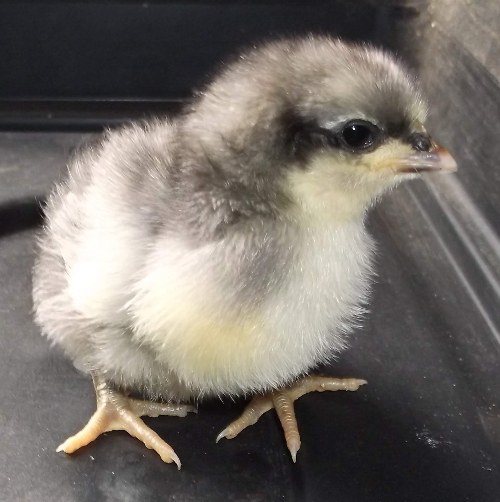
Below: A Blue Andalusian Grower.

Below: A Blue Andalusian Hen.
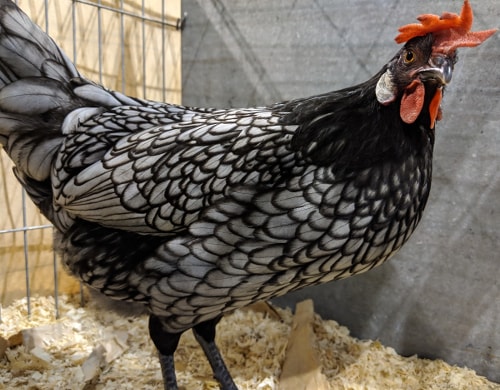
Below: A Blue Andalusian cockerel.
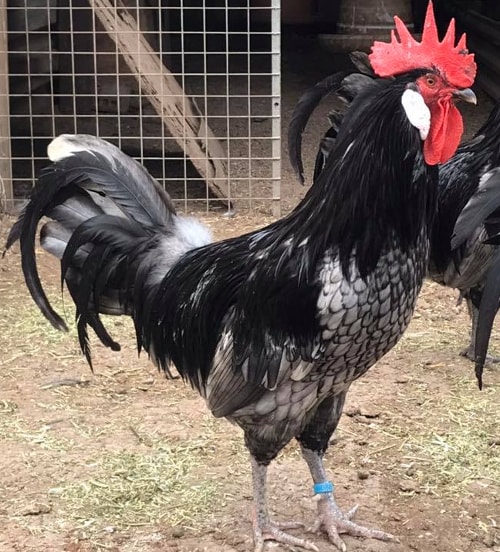
Breed video:
Brief history of the Andalusian:
Developed in the Andalusia, Southern Spain, Andalusians are closely feathered, active and good layers of large white eggs. Blue is the only variety accepted by the APA, but when two blues are crossed, 25% will be black and 25% will be white.
The true origins of this breed are unknown, but it is likely that the land-race chickens (known as Black Castilians) were bred together or with other local breeds of Castile, Spain, to create this particular breed.
Below: Picture of Blue Andalusians from an old poultry book.
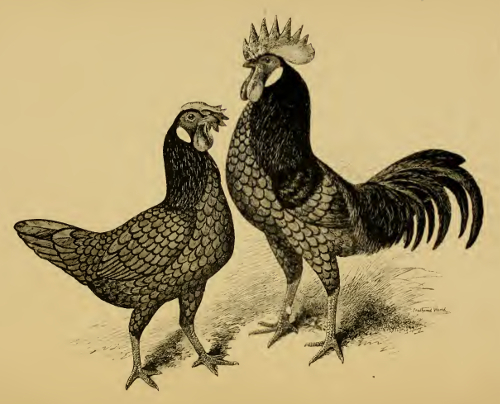
Lucius Columella, a Roman agricultural writer, mentioned the Mediterranean fowl breeds in his writings De Re Rustica.
Andalusian chickens are indigenous to Spain. Also called Blue Andalusians, they commonly have slate-blue coloured plumage, but depending upon genetics, they can also be off-white or even black. Like other Mediterranean breeds, they have white earlobes. Their light body shape and their large pointed combs make them well-suited for warmer climates. Andalusians are very active foragers, so think twice if you keep your poultry in a coop and run. They do not do well in confinement, and thrive in a free-range environment. Hens lay about 200 white eggs per year.
The name Andalusian is a bit of a misnomer. In 1879 Harrison Weir visited the southern part of Spain, where the district of Andalusia is located, and inquired about the Blue Andalusian chicken.
To his surprise the bird he was looking for was mostly unknown. So it is assumed that this breed has no special connection to Andalusia Spain. However, there are two other accounts that blue-coloured chickens were found in other parts of Spain.
Granted it is not uncommon to find blue-coloured birds in mixed flocks where both black and white birds are found, so it is still not out of the question that the original “Andalusian” came from Spain. Most likely, the breed was first exported to England via Cadiz, which is in the province of Andalusia. This gave the English breeders the idea that they were common in Andalusia.
Andalusian breeding and colour chart:
When you breed Andalusians the following combinations are achievable:
- Blue X Blue = 50% Blue, 25% Black, 25% Splash
- Blue X Black = 50% Blue, 50% Black
- Blue X Splash = 50% Blue, 50% Splash
- Black X Black = 100% Black
- Splash X Splash = 100% Splash
- Splash X Black = 100% Blue
Below: Colour chart showing what colour chicks you get from different colour matings.

So the best way to produce all blue birds is to breed a splash and a black chicken.
Breed FAQ:
What colour eggs does the Andalusian lay?
The Andalusian lays a large white egg. I have found them to be one of the nicest eggs I have eaten as they spend so much time foraging. The shell is chalk white, smooth and very strong, thus standing shipment and handling exceedingly well.
Below: A selection of eggs from the Andalusian chicken.
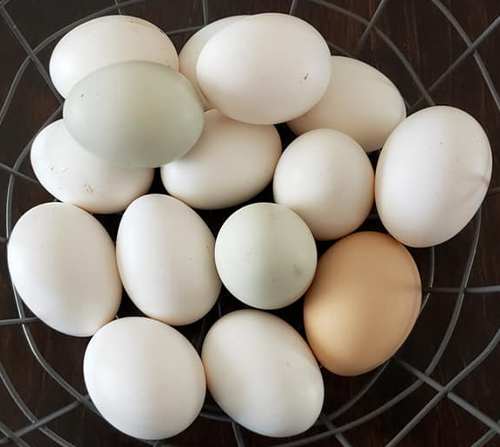
Are Andalusian good layers?
Yes they are, Andalusians are some of the best layers around as far as rare breeds go. They produce 200 eggs in their first year and remain productive for a long time. I have 5 year old birds still producing 2 to 3 eggs a week and they never seem to suffer from egg problems like some hybrids do.
Are Andalusian chickens friendly?
Andalusians are not unfriendly as such but don't like to be still and mine are not great for being petted. If you are after pet family friendly chickens then these are probably not for you.
How big is a Andalusian chicken?
They are a large bird with an upright stance, a little taller and bigger than leghorns.
The male standard size or large fowl is 22 to 26 inches (55 to 66 cm) to tall and weighs 3.2–3.6 kg while the male bantam: 14 to 17 inches (35 to 45 cm) tall and weighs around 680–790 g.
The female of the species is a little smaller, with the large fowl standing at 20 to 25 inches (50 to 60 cm) tall and weighing in at 2.25–2.70 kg and the female bantam standing around 12 to 15 inches (31 to 38 cm) tall and weighing 570–680 g
Where do Andalusian come from?
The Andalusian chicken is indigenous to the region Andalusia in south-west Spain, although the distinctive Blue Andalusian was developed in England. Each feather is a slate blue, laced with dark blue or black. With a white earlobe and brilliant red comb, it has a very striking presence.
Do Andalusian need any special care?
They are active foragers that like space and really need plenty of land to roam on. Like with Leghorns, the large comb can suffer from frostbite. Otherwise they are hardy and sturdy birds that seem to weather most conditions just fine.
Below: Blue Andalusians seem to moult fast and lose a lot of feathers very quickly.
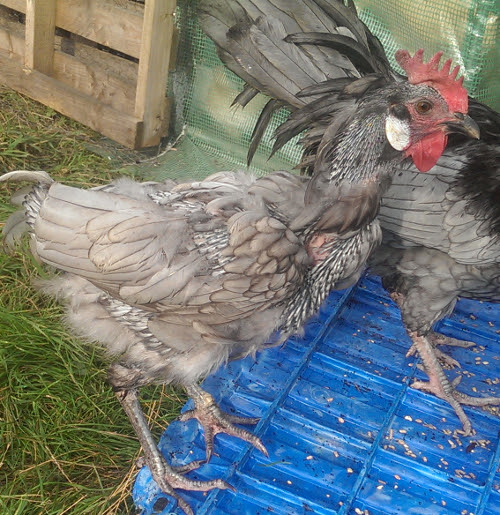
I have also found that they moult quickly and lose a lot of their feathers at a time. This fast moulting can mean they need some shelter late in the year as they grow new feathers.
How old are Andalusian chickens when they start laying eggs?
The hens develop fast and begin to lay early at around 5 or 6 months of age. Birds raised early in the season will begin to lay at the in the same year.
How long do Andalusian chickens live?
Andalusians are a long lived race of persistent producers. I have several hens well up in years that are still giving us production to warrant our keeping them over for another year or more.
I have two hens that are ten years old, still in good condition, that laid few huge eggs early in spring.
How much space do Andalusian need?
Quite a lot and they run fast, really fast. I have to wait until they roost for the night to check them over. They like a tall coop with high roosts and fly well.
Are Andalusian roosters aggressive?
They are an independent and occasionally aggressive bird that does not tolerate confinement well and prefer to find their own roosting spots.
Are Andalusian hens broody?
Andalusian chickens are no sitters and rarely go broody. In my flock I can count on one hand the number of times I have had a broody hen in the last 5 years. It never happens in their first year and always seems to be older hens in years three and four that get the urge to go broody.
When they do hatch a clutch they are good mothers but prefer small broods of six to eight chicks.
Where to get and how much to pay for them:
Trying to find Andalusian hens for sale is always going to be difficult. They always tend to be expensive as there is 50% wastage in producing the blue colour. Quite a few hatcheries stock the birds if you are happy with hatchery chicks and the prices start from $5 per chick.
Expect to pay upwards of $30 each for sexed growers, $50 for fully grown point of lay hens and as much as $100 for a show quality pair.
You can find them by joining a breed society, looking at the rare breeds survival trust for registered breeders and looking on Facebook for groups specialising in Mediterranean chickens.
Blue Andalusian breed standard and requirements for shape and colour:
SHAPE OF MALE:
HEAD: Moderately long and deep ; face, full and smooth, fine in texture.
BEAK: Of moderate length, nicely curved.
EYES: Large and oval.
COMB: Single, medium size, smooth, straight and upright; firm and even on the head, evenly and deeply serrated; having five points, the middle point standing directly over the centre, being broader at the base and slightly taller than either of the other four; blade slightly following the curve of the neck.
WATTLES AND EAR-LOBES: Wattles; thin, smooth, well rounded and of medium length. Ear-lobes, almond shaped, of moderate size, smooth and free from wrinkles.
NECK: Rather long, well arched with abundant hackles falling well over the shoulders.
WINGS: Large and well folded.
BACK: Rather long, broad and high at shoulders, sloping downward to the rear of saddle; then rising with an abrupt sweep to tail; slightly narrowing from front to rear; saddle feathers moderately long and abundant.
TAIL: Medium length, full, fairly well spread; main tail feathers carried at an angle of forty degrees above the horizontal; sickles long and well curved; coverts abundant.
BREAST: Broad, deep, well rounded; carried well up and forward.
BODY AND FLUFF: Body; long, well rounded, medium depth from front to rear; broad at shoulders and slightly narrowing as it approaches the stern. Fluff; rather short and compact.
LEGS AND TOES: Thighs of moderate size, rather long; hock joints showing well below the body line; shanks long, standing well apart; toes straight.
SHAPE OF FEMALE
HEAD: Moderately long, deep, full, and smooth.
BEAK: Moderate length, nicely curved.
EYES: Large, full.
COMB: Single, of medium size, evenly and deeply serrated, having five points, the front portion of the comb and the first point standing erect, and the remainder of the comb drooping gradually to one side; fine in texture and free from folds and wrinkles.
WATTLES AND EAR-LOBES: Wattles, thin, smooth, well rounded, and of moderate length. Ear-lobes, almond shaped and of moderate size and smooth.
NECK: Rather long, gracefully arched.
WINGS: Large, well folded.
BACK: Rather long, broad, and straight, high at shoulders and sloping downward to rear of cushion, gradually narrowing as it approaches the stern, rising with a short sweep to the tail.
TAIL: Long, full, medium spread, carried at an angle of forty degrees above horizontal.
BREAST: Broad and well rounded, carried well up and forward.
BODY AND FLUFF: Body, long, well rounded, of medium depth from front to rear, broad at shoulders and slightly narrowing as it approaches the stern. Fluff, rather short and compact.
LEGS AND TOES; Thighs of moderate size, rather long, hock joints showing well below the body line. Shanks long; toes straight.
COLOUR OF MALE:
HEAD: PLUMAGE: A dark shade of slate blue with a comparatively broad lacing: of a darker lustrous blue.
BEAK: Horn.
EYES: Reddish bay.
COMB, FACE AND WATTLES: Bright red.
EAR-LOBES: White.
NECK: Ground colour, a clear, even, medium shade of slate blue, each feather having a clear, broad and well defined lacing of a very dark lustrous blue, the lacing gradually widening as it approaches the tip.
WINGS: Bows; ground colour, clear, even, medium shade of slate blue, each feather having a broad lacing of a dark lustrous blue. Coverts; a clear, even, medium shade of slate blue, each feather having a clear and well defined lacing of a darker blue. Primaries; a clear, even, medium shade of slate blue, laced with a darker blue. Secondaries; outer web, a clear, even, medium shade of slate blue, laced with a darker blue. Inner web, a clear, even, medium shade of slate blue, laced with a darker blue.
BACK: Ground colour, a clear, even, medium shade of slate blue, each feather having a broad, clear, well defined lacing of a very dark lustrous blue, the lacing gradually widening as it approaches the tip of the feather.
TAIL: Sickles, dark, slate blue, laced with a darker blue. Coverts a clear, medium shade of slate blue, laced with a darker blue.
MAIN TAIL FEATHERS: A clear, even, medium shade of slate blue, laced with darker blue.
BREAST: A clear, even, medium shade of slate blue, each feather having a clear and well defined lacing of a darker blue.
BODY AND FLUFF: Clear, even, medium shade of slate blue, each feather having a clear and well defined lacing of darker blue. Fluff, a medium shade of slate blue, laced with a darker blue.
LEGS AND TOES: Thigh, a clear, even, medium shade of slate blue, laced with a darker blue. Shanks, leaden blue. Toes, leaden blue.
UNDERCOLOUR: In all sections a slate blue, the shade varying with degree of lacing.
COLOUR OF FEMALE:
HEAD: Slate blue, heavily laced with a darker blue.
BEAK: Horn.
EYES: Reddish bay.
COMB, FACE AND WATTLES: Bright red.
NECK: A clear, even, medium shade of slate blue, heavily laced with a darker blue.
WINGS: Bows; a clear, even, medium shade of slate blue, with a clear and well defined lacing of darker blue. Coverts; a clear, even medium shade of slate blue, each feather having a clear and well defined lacing of darker blue. Primaries; a clear, even medium shade of slate blue, laced with a darker blue. Secondaries; a clear, even, medium shade of slate blue, laced with a darker blue.
BACK: A clear, even, medium shade of slate blue, each feather having a clear and well defined lacing of darker blue.
TAIL: Main feathers a clear, even, medium shade of slate blue, laced with a darker blue. Coverts; a clear, even, medium shade of slate blue, each feather having a clear and well defined lacing of a darker blue.
BREAST: A clear, even, medium shade of slate blue, each feather having a clear and well defined lacing of a darker blue.
BODY AND FLUFF: Body, a clear, even, medium shade of slate blue, each feather having a clear and well defined lacing of darker blue. Fluff, a clear, even, medium shade of slate blue, laced with a darker blue.
UNDER COLOUR: In all sections of slate blue, the shade varying with width of lacing in each section.
LEGS AND TOES: A clear, even, medium shade of slate blue, laced with a darker blue. Shanks and toes, leaden blue.
